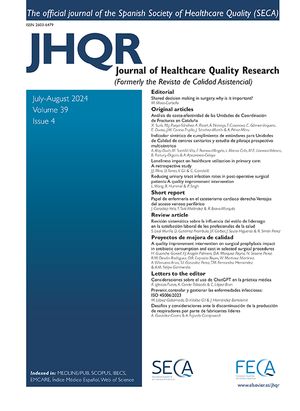Información de la revista
Vol. 16. Núm. 2.
Páginas 83-85 (enero 2001)
Vol. 16. Núm. 2.
Páginas 83-85 (enero 2001)
Acceso a texto completo
Top be or not Top be
Visitas
1745
Ricard Meneu
Fundación Instituto de Investigación en Servicios de Salud
Este artículo ha recibido
Información del artículo
El Texto completo está disponible en PDF
Bibliografía
[1.]
L. García-Eroles, C. Illa, A. Arias, M. Casas.
Los Top 20 2000: objetivos, ventajas y limitaciones del método.
Rev Calidad Asistencial, 16 (2001), pp. 107-116
[2.]
S. Peiró.
Los mejores hospitales. Entre la necesidad de informaci ón comparativa y la confusión.
Rev Calidad Asistencial, 16 (2001), pp. 119-130
[3.]
G. Debord.
Pre-Textos, (1999),
[4.]
100 Top Hospitals™: National Benchmarks for Success-2000 (página web). Accesible en: http://www.100tophospitals.com/studies/national00/methodology.htm (acceso 2/2/2001).
[5.]
J. Green, N. Wintfeld, M. Krasner, C. Wells.
In search of America?s best hospitals. The promise and reality of quality assessment.
JAMA, 277 (1997), pp. 1152-1155
[6.]
John & Sons, Incorporated, (1995),
[7.]
P. Houdart, F. Mayle, J. Vincent.
Le palmarès des hôpitaux.
Sciences et Avenir, 619 (1998), pp. 32-71
[8.]
Alianza Universidad, (1973),
[9.]
M.N. Marshall, P.G. Shekelle, S. Leatherman, R.H. Brook.
The public release of performance data: what do we expect to gain? A review of the evidence.
JAMA, 283 (2000), pp. 1866-1874
[10.]
R.M. Poses, D.K. McClish, W.R. Smith, E.C. Huber, L.W. Clemo, B.P. Schmitt, et al.
Results of report cards for patients with congestive hearth failure depende on the method used to adjust for severity.
Ann Intern Med, 133 (2000), pp. 10-20
Copyright © 2001. Sociedad Española de Calidad Asistencial






